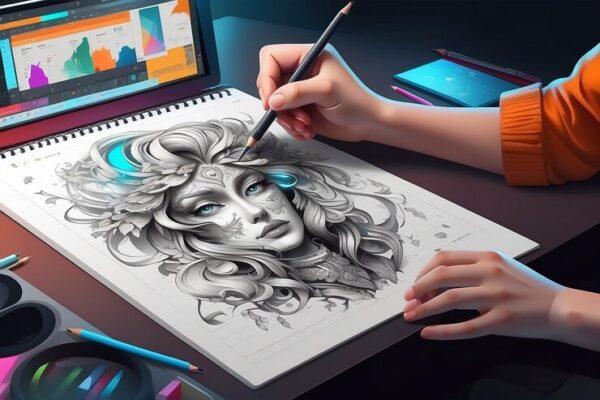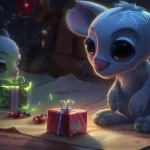Introduction To creative:bw8dqizhyro= drawings
What Are Creative Drawings?
Creative drawings represent an extraordinary facet of artistic expression where imagination reigns supreme. These artworks transcend traditional boundaries, embracing the unorthodox and the whimsical. Unlike technical or academic drawings, creative drawings convey emotions, ideas, and visions through the inventive use of lines, shapes, and colours. They offer a unique glimpse into the artist’s mind, often challenging conventional aesthetics and norms.
The Role of Imagination in Drawing
Imagination is the driving force behind creative drawings. It allows artists to explore and represent concepts that go beyond the mundane. Just as a composer might create an orchestral piece from a melody, an artist transforms abstract thoughts into visual form. Imagination fuels innovation, enabling artists to craft visual stories that resonate on both personal and universal levels.
The Evolution of Creative Drawings
Historical Perspectives on Creative Art
Creative drawing has a rich history that reflects different eras’ cultural and technological advancements. Ancient cave paintings and early sketches provide insight into the early human experience, often imbued with symbolic meanings. The Renaissance marked a significant shift, emphasizing realism and anatomical precision, while subsequent movements like Impressionism and Surrealism explored new ways of seeing and interpreting the world.
How Creative Drawings Have Evolved Over Time
The evolution of creative drawings mirrors technological advancements and cultural shifts. Each era has introduced new techniques and materials, from traditional pen and ink to digital media. The development of printing technologies, photography, and digital tools has expanded the possibilities for creative expression, allowing artists to experiment with new forms and styles. The progression from hand-drawn illustrations to complex digital art reflects broader changes in society and technology.
Understanding Creative Drawings
Defining Creative Drawings
Creative drawings are distinguished by their emphasis on originality and personal expression. Unlike technical drawings, which prioritize accuracy and precision, creative drawings embrace spontaneity and experimentation. They often feature unconventional techniques and materials, reflecting the artist’s unique perspective and vision. These drawings are not just about creating visually pleasing images but also about evoking emotions and provoking thought.
Critical Characteristics of Creative Drawings
Several characteristics define creative drawings. They often exhibit a high degree of personal style and originality, breaking away from traditional norms and exploring new methods of expression. Creative drawings may incorporate abstract forms, unconventional materials, and innovative techniques to convey the artist’s vision. The focus is on creativity and emotional impact rather than technical perfection.
Materials and Techniques
Essential Drawing Materials
Understanding and acquiring suitable materials is essential to embark on your journey into creative drawing. Basic supplies include:
- Pencils: Pencils range from hard (H) to soft (B) and are versatile tools for sketching and shading.
- Charcoal: Ideal for rich, expressive lines and textures.
- Ink: Provides bold, defined lines and can be used with various tools such as pens and brushes.
- Pastels: Offer vibrant colours and can be blended for different effects.
- Paper: The choice of paper affects the texture and appearance of your drawing. Options include sketch paper, watercolour paper, and mixed media paper.
As you progress, exploring additional materials such as markers, coloured pencils, and paints can enhance your creative repertoire.
Popular Techniques for Creative Drawings
Techniques in creative drawing vary widely, providing artists with numerous ways to express their ideas:
- Cross-Hatching: A technique where intersecting lines create shading and texture.
- Blending: Softens lines and gradients, creating smooth transitions between light and dark areas.
- Stippling: Uses dots to build texture and shading, offering a distinct visual effect.
- Gesture Drawing: Focuses on capturing the essence and movement of the subject with quick, expressive strokes.
- Mixed Media: Combines various materials and techniques, such as incorporating collage elements or using digital tools alongside traditional media.
Experimenting with these techniques lets you discover what suits your style and creative goals best.
Drawing Styles and Influences
Abstract vs. Realistic Drawings
Creative drawings can be categorized into various styles, with abstract and realistic being two prominent examples:
- Abstract Drawings prioritize form, colour, and composition over representational accuracy. They often convey emotions or concepts through non-representational means, allowing for various interpretations.
- Realistic Drawings: Aim to depict subjects as they appear in reality accurately. This style requires a high degree of technical skill and attention to detail, focusing on capturing the likeness and nuances of the subject.
Both styles offer unique opportunities for creative expression and can be combined or adapted to suit your artistic vision.
The Impact of Different Art Movements
Art movements have profoundly influenced the evolution of creative drawings. Some notable movements include:
- Renaissance: Emphasized realism, perspective, and anatomical accuracy, significantly shaping the development of drawing techniques.
- Impressionism: Focused on capturing light and colour, using loose brushstrokes and vibrant hues.
- Surrealism: Explored dream-like and fantastical imagery, often challenging conventional reality and logic.
Each movement introduced new ideas and methods, expanding the possibilities for artistic expression and influencing contemporary drawing practices.
How to Get Started with Creative Drawings
Tips for Beginners
Starting with a creative drawing can be both exciting and daunting. Here are some tips to help you get started:
- Start Simple: Build your skills and confidence with basic shapes and forms.
- Practice Regularly: Consistent practice is critical to improving your technique and style.
- Experiment: Feel free to try new materials, techniques, and styles. Exploration is essential for growth.
- Seek Feedback: Share your work with others and seek constructive feedback to gain new perspectives and insights.
Building Your Drawing Skills
To advance your drawing skills, consider the following strategies:
- Study Other Artists: Analyze the work of established artists to understand their techniques and approaches.
- Attend Workshops: Participate in art workshops and classes to learn new skills and techniques.
- Set Goals: Establish specific goals for your artistic development and work towards achieving them.
Continued practice and exploration will help refine your skills and discover your unique artistic voice.
Inspiration for Creative Drawings
Finding Inspiration in Everyday Life
Inspiration for creative drawings often comes from observing the world around you. Consider these sources of inspiration:
- Nature: The beauty and complexity of natural landscapes, plants, and animals can provide endless ideas.
- People: Portraits and figures can capture a range of emotions and stories.
- Urban Environments: Cityscapes, architecture, and everyday scenes offer unique visual elements and perspectives.
Keeping a sketchbook to document your observations and ideas can be a valuable tool for capturing inspiration as it strikes.
Using Technology and Media for Inspiration
Technology and media offer additional avenues for inspiration:
- Social Media: Platforms like Instagram and Pinterest showcase diverse artworks and trends.
- Art Blogs and Websites: These resources provide insights into current art trends, techniques, and artist interviews.
- Digital Tools: Software and apps can help you experiment with different styles and effects, offering new creative possibilities.
Utilizing these resources can help you stay informed and inspired as you develop your artistic practice.
Showcase of Famous Creative Drawings
Influential Artists and Their Work
Many artists have made significant contributions to the world of creative drawing. Some influential figures include:
- Leonardo da Vinci: Known for his detailed anatomical sketches and innovative techniques.
- Vincent van Gogh: His expressive use of line and colour in sketches and studies reveals his emotional depth.
- Pablo Picasso: Revolutionized drawing with his abstract and fragmented approach, challenging traditional perspectives.
Studying the work of these artists can provide valuable insights and inspire your creative endeavours.
Iconic Creative Drawings Throughout History
Specific drawings have become iconic for their creativity and impact. Examples include:
- Da Vinci’s Anatomical Studies: These detailed sketches revolutionized our understanding of human anatomy.
- Van Gogh’s Sketches of the Starry Night: These sketches capture the swirling motion of the night sky and reflect his unique vision.
- Picasso’s Cubist Sketches: These works demonstrate his departure from realism and explore new ways of representing form and space.
These iconic drawings not only showcase technical skill but also embody the spirit of artistic innovation and experimentation.
Common Challenges and Solutions
Overcoming Artist’s Block
Artist’s block can be a frustrating challenge, but several strategies can help you overcome it:
- Change Your Environment: A new setting can stimulate creativity and provide fresh perspectives.
- Try New Techniques: Experimenting with different methods can break the monotony and spark new ideas.
- Take Breaks: Allowing time away from work can help reset your creativity and provide new insights.
By proactively addressing artists’ block, you can maintain your creative momentum and continue developing your artistic skills.
Common Mistakes and How to Avoid Them
Mistakes are a natural part of the creative process, but some common issues can be mitigated:
- Perfectionism: Avoid getting bogged down by the need for perfection. Embrace imperfections as part of the creative journey.
- Lack of Experimentation: Not trying new techniques or materials can limit your artistic growth. Embrace experimentation to expand your creative boundaries.
- Neglecting Basics: Even in creative drawing, a strong understanding of fundamental principles, such as composition and perspective, is essential.
Recognizing and addressing these common mistakes can enhance your artistic practice and growth.
The Impact of Creative Drawings on Society
Art as a Reflection of Culture
Creative drawings often reflect the cultural and social context in which they are created. They can offer commentary on societal issues, express cultural identities, and capture historical moments. Art serves as a powerful medium for communicating ideas and influencing public discourse.
The Role of Art in Personal and Professional Development
Engaging in creative drawing can have significant personal and professional benefits:
- Personal Growth: Art can be a form of self-expression and emotional release, contributing to individual well-being and growth.
- Professional Opportunities: Developing a portfolio of creative work can lead to career opportunities in illustration, design, and art education.
Embracing creative drawing as a personal and professional pursuit can lead to a fulfilling and rewarding experience.
Future Trends in Creative Drawings
The Influence of Emerging Technologies
Emerging technologies like augmented reality (AR) and virtual reality (VR) are transforming the field of creative drawing. These technologies offer immersive experiences and new ways to interact with art, allowing artists to explore new dimensions and possibilities. Keeping an eye on technological advancements can open up exciting new opportunities for artistic expression.
Predictions for Future Trends
As technology and cultural trends evolve, so will the field of creative drawing. Future trends may include:
- Greater Integration of AI: AI tools may offer new ways to generate and manipulate art, expanding creative possibilities.
- Interactive Experiences: Interactive and immersive art experiences may become more prevalent, allowing audiences to engage with art in novel ways.
- Exploration of Mixed Media: Continued exploration of mixed media and hybrid forms may lead to new and innovative artistic expressions.
By staying informed about future trends, artists can remain at the forefront of innovation and continue pushing the boundaries of their creativity.
How to Share and Promote Your Creative Drawings
Platforms for Sharing Art
There are numerous platforms where you can share your creative drawings, including:
- Social Media: Platforms like Instagram, Facebook, and Twitter offer wide-reaching visibility and engagement opportunities.
- Online Art Communities: Websites such as DeviantArt and Behance provide spaces for artists to showcase their work and connect with others in the art community.
- Personal Websites: Creating a personal website allows you to present your portfolio professionally and control how your work is displayed.
Choosing the right platforms for sharing your art can help you reach your target audience and achieve your artistic goals.
Building an Audience
Building an audience for your creative drawings involves:
- Consistent Sharing: Regularly post your work to engage your audience and attract new followers.
- Engaging with Followers: Respond to comments, participate in discussions, and build relationships with your audience.
- Participating in Art Communities: Join online forums and local art groups to network with other artists and potential fans.
You can grow your presence and build a dedicated following by actively engaging with your audience and art community.
Conclusion
Creative drawings are dynamic and personal artistic expressions that have evolved over centuries. By exploring different materials, techniques, and styles, artists can continually push the boundaries of their creativity. Embrace your imagination, experiment with new ideas, and share your work. The journey of creating and appreciating creative drawings is a rewarding experience that enriches both the artist and the viewer.
FAQs
- What are the best materials for creative drawings?
Pencils, charcoal, ink, pastels, and various types of paper are the best materials for creative drawings. Each material offers unique qualities and effects, allowing artists to experiment and find what works best for their style.
- How can I overcome the artist’s block?
Overcoming artist’s block can be achieved by changing your environment, trying new techniques, and taking breaks. Engaging in activities unrelated to art, such as exploring nature or reading, can also spark creativity.
- What are some famous examples of creative drawings?
Famous examples of creative drawings include Leonardo da Vinci’s anatomical studies, Vincent van Gogh’s sketches, and Pablo Picasso’s abstract works. These drawings showcase different styles and innovations in the art world.
- How can technology enhance my drawing skills?
Technology enhances drawing skills through digital tools like drawing tablets and software. These tools offer advanced features for creating and manipulating art, making experimenting and refining your skills easier.
- Where can I share my creative drawings?
You can share your creative drawings on social media platforms, online art communities, and personal websites. Each platform provides different opportunities for exposure and engagement with your audience.



